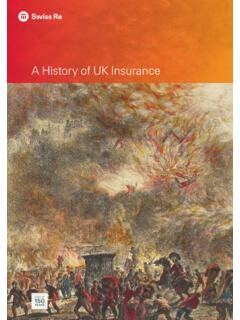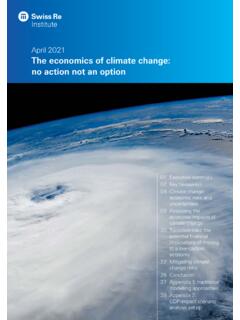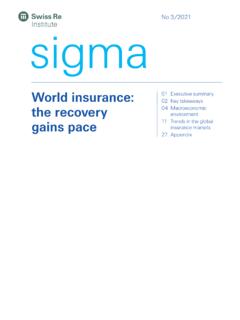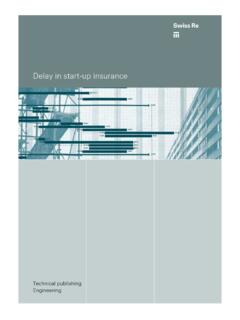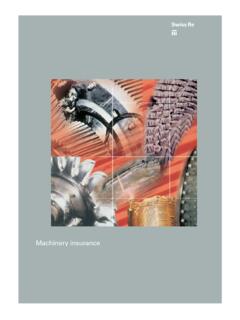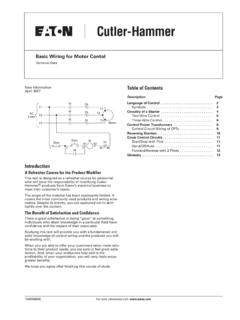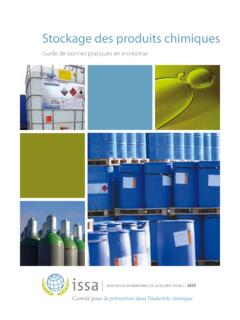Transcription of Engineering insurance and reinsurance - An introduction
1 Engineering insurance and reinsuranceAn introductionEngineering insurance and reinsuranceAn insurance historical classes of business a does Engineering insurance begin? (one-off) Contractors All Risks Erection All Risks Contract Works All Risks Extensions of cover and special clauses Advance Loss of Profits covers Contractors Plant and Equipment Boiler and Pressure Vessel Explosion Machinery Breakdown Loss of Profits following Machinery Breakdown Deterioration of Stock Computer All Risks Low Voltage and Electronic Equipment All Risks Forms and types of Engineering Engineering treaty wordings terms and Recent developments in and Swiss well-known dictionary definesengineering as the activities or functionof an engineer and the application ofscience and mathematics by which theproperties of matter and the sources ofenergy in nature are made useful topeople in structures, machines, products,systems, and processes.
2 Both of thesedefinitions have a strong relationship tothe words Engineering insurance , whichthe insurance industry uses as a collectiveterm to describe various types of policiesfor the protection of construction works,as well as the erection and operation are several specialised publicationswhich deal with the individual lines ofengineering insurance , but few whichgive an overview of this complex andextremely interesting branch. Thisbulletin attempts to provide a basicintroduction to Engineering insuranceand reinsurance . It is intended forcompanies and underwriters who as yethave no profound experience in thisfascinating insurance historical reflections7 From 1920 to 1930, some German andBritish companies introduced a contrac-tors policy providing insurance cover forbuildings and civil works during thecourse of construction.
3 Based on thispolicy, Contractors and Erection AllRisks policies were developed. However,neither of these types of policies reachedany great importance until after WorldWar II when postwar reconstruction anddevelopmentbroughtthese covers totheirpresent the advance of technology, otherengineering policies such as ComputerAll Risks, Low Voltage and ElectronicEquipment All Risks, and DeteriorationofStockfollowingMachineryBr eakdownwere developed, along with businessincomeprotectioncoverssuchasAdva nceLoss of Profits, written in conjunctionwith Contractors All Risks and ErectionAll Risks , new Engineering insurance pro-ducts are being sought. New insuranceneeds are arising in respect of risks suchas prototype machinery, contractualliabilities and guarantees, and certain po-litical risks (expropriation, confiscation,change of law etc) which have so far beenconsidered needshavebeen largely brought about by the after-math ofnewproject finance methods, andthe transfer of these risk elements is oftenimposed by project financiers.
4 In ordertomeetthisdemand,newinsurance solu -tions for example in the fields of non-vitiation, liquidated damages, availabilityand performance guarantees have beenand are being developed. At Swiss Re, webelieve that Engineering insurance willcontinue to evolve. The Engineering in-surance industry will undoubtedly havetoremain flexible and adapt itself to newinsurance needs as a result of the hugetechnological advances which the worldis facing. The origins of Engineering insurance areto be found in the inspection of steamboilers. In the nineteenth century, inGreat Britain during the industrial revo-lution, the frequent occurrence of explo-sions involving serious property damageand loss of life made it necessary to takesteps to guard against such dangers. In1854, prominent gentlemen interested intheuseofsteamdecided toform the Man-chesterSteamUsers Association.
5 Memberswere entitled to use the services of boilerinspectors who were employed by theassociation. This organization not onlygave advice on how to prevent explosionsbut also undertook to guide its membersin the most advantageous and economi-cal method of using the plant. Thisprinciple is still maintained today. Plantowners can call upon the engineer-surveyor for advice and suggestions onplant operation and the Manchester Steam Users Association rendered valuable services, itwas not an insurance company. In 1858,however, in response to an evident need,certain members founded the first engi-neering insurance company, the SteamBoiler Assurance Company. This com-pany started with the insurance of boi-lers, and its lead was soon followed bythe formation of similar companies. Atfirst only boilers were insured, but coverswere gradually extended to pressure ves-sels of various kinds.
6 Engine insurance (known today as Machinery Breakdowninsurance) began in 1872, and both boil-er explosion and engine covers rapidlyspread to other industrialised the beginning of the twentieth century, the first insurance policies forloss of profits following machinerybreakdown were being issued. At thesame time, erection insurance (coveringthe on-site erection and assembly of machines) appeared. The policy was on a named perils basis and did not coverfire, but it offered reasonable protectionfor small and medium-sized classes of business a summary9 The classes of business under the collec-tive heading Engineering insurance canbe categorised as either property orbusiness income protection policies; andas either non-renewable or annuallyrenewable covers:In principle, there are business incomeprotection covers which dovetail withpractically all Engineering propertycovers.
7 However, in this publication onlythe most common types are dealt with,bearing in mind that Engineering insur-ance is essentially a material of the policies are of the broad, all risks type (property insurance againstphysical damage by all risks of lossexcept those specifically excluded), whichoffer protection against human andtechnical errors and the perils of combinations of cover are alsopossible: for example cover for contrac-tors plant and equipment may be endorsed to CAR, EAR and CWAR policies, or boiler and pressure vesselexplosion to an MB renewable Engineering propertyand business income protection coversare also encountered under Industrial AllRisks (IAR) policies a multiline packagepolicy which can include fire, marine,liability and Engineering . It is usuallybought by large industrial or commercialenterprises to protect all of their installa-tions, whether at home or abroad.
8 Policyforms are either standard or tailor-madealthough one form customarily domi-nates in each country. The main problemlies in interpreting the cover: all possiblerisks even unknown ones are insuredunless explicitly excluded. Loss adjust-ment can also cause headaches, especiallyin the field of business income protec-tion. Therefore, if written, it is impera-tive to ensure that the cover concept istransparent, that the IAR policy does notundermine the conditions usually appli-cable to the respective mono-line covers,that risk assessment is carried out sepa-rately for each type of mono-line, thatthe premium is commensurate with therisk, and that no technically unjustifieddiscount is given. Property coversAbbreviationContractors All Risks CAR1(synonyms: Builders Risks, Course of Construction)Erection All RisksEAR1 Contract Works All RisksCWAR1 Contractors Plant & EquipmentCPE2 Machinery Breakdown (synonym.)
9 Boiler and Machinery)MB2 Boiler&Pressure Vessel ExplosionBPVE2 Computer All RisksCOMP2 Low Voltage & Electronic Equipment All RisksLVEE2 Business income protection coversAdvance Loss of Profits in conjunction with CAR, EAR, CWARALOP1 Loss of Profits following MBMLOP2 Deterioration of Stock following MBDOS21= Non-renewable (or one-off) covers 2= Annually renewable coversPossible coversFrom feasibility study to operationOff-site activitiesOn-site activitiesFeasibility studyTransportConstructionOperationDesig nErectionManufacturingCommissioning/test ingFire & Extended CoverageMarineContractors All Risks (CAR)Fire & Extended CoverageProfessional IndemnityStorageErection All Risks (EAR)Fire Loss of ProfitsContract Works All Risks (CWAR)LiabilityAdvance Loss of Profits (ALOP)Contractors Plant Contractors Plant and Equipment (CPE)and Equipment (CPE)Boiler and Pressure Vessel Explosion (BPVE)Machinery Breakdown (MB)Loss of Profits following MB (MLOP)Deterioration of Stockfollowing MB (DOS)Computer All Risks (COMP)Low Voltageand ElectronicEquipment All Risks (LVEE) Engineering insurance involvement Engineering does Engineering insurance begin?
10 Most projects usually start with afeasibility study. The CAR, EAR orCWAR policy (sometimes inconjunction with an ALOP cover)incepts at the beginning of theconstruction or erection phase and endsupon completion of the project. Then,depending on the type of risk, one orPhasemore of the annually renewable types ofengineering policies provide cover duringthe operational phase. The exception to this flow is the annually renewable CPE policy which, depending on what isactually insured, may be in force duringeither the construction/erection phase orthe operational phase, or both. (one-off) coversNon-renewable policies are concludedfor projects under construction and/orerection. The sums insured for such pro-jects can easily reach millions of dollars,resulting in a real need for insurancecover for principals and contractorsalike. In some markets, it is compulsoryto insure construction and erectionprojects.
